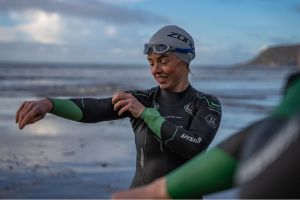Best tips for open water swimming are the simple ones really!
Get a wetsuit that fits you and fits well, it’s worth taking your time here. You would not go for a run wearing trainers that are too small or too big or ride a bike like a barn door if you are 5’4…as they say try before you buy. It’s worth trying a few different models out as well. Some are designed to keep you extra warm in proper cold water, and some have extra flexibility or are designed to give you extra buoyancy. The best one for you is the correct fit with the best properties for what you want the wetsuit for.
Before your swim:
Always put some anti-chafing balm on your neck and under your arms if you are wearing a race suit underneath. Especially if you are wearing a new suit and if you are swimming in the sea, that salt water can really chafe.
Small things will make it a much more enjoyable experience. Take some flip flops so you can walk to the water’s edge and put some anti-fog into your goggles as sighting is key when swimming open water. I always wear a bright swim cap and if the current and swell is big, I wear a safety buoy around my waist for extra visibility. Take a bag to put all your wet kit in after your swim, maybe have a warm hat or big parker if you know you will be cold after.
Entering the water:
Enter the water slowly and get used to the water. If you are new to swimming in open water and feeling nervous, don’t stress about everyone around you, take your time and get comfortable in the water before you start you swim. I recommend having a session or set plan ready and I always do my open water swims on time, not distance. It is a good idea to get in and only do a small warm up, as come race day it is very rare that you can do any swim warm up at all. It is important to train to race; mimic a race day situation in training so come the big day, it is service as normal. Due to the new rolling start to most big races, it will benefit you to be used to the process of getting in and just swimming at race pace with no warmup.
Work on sighting when you are swimming ‘hard’ or at least at race pace and not just when you are swimming easy. It’s better to train to race, not train to train, so you need to practice the things we need to do in races in training. Pick a point, such as a buoy on the horizon, to swim to. You want to swim from A to B in as straight line as possible.
Swimming with others of a similar ability can really heighten your training. Get in the hustle and bustle and practice swimming on feet or swimming round people. Swim tight and not in a loose group, just like a race situation. You could also take it in turns to lead the group and sit in on the feet or hip, this way when it comes to race day you will be used to the larger groups around you. By swimming on the feet, you can save up to 30% energy… think about that, it’s like drafting on the bike but its legal in the water! When you have finished your swim, do the last few 100m at pace and add in some extra kick to get some of that blood into your legs so you are ready to hit dry land, and really take your wetsuit off fast a race simulation so to speak. It makes so much sense to practice this and then work out how to do it fast. Practice makes perfect right, and in a race, you will be so much more stressed in transition (trust me) so let’s take some of that away by having a routine, a flow, a process to smooth out that T1 and get you ready for the bike.
And remember to enjoy your swim, whether it be river, lake, sea or even a pond. Get in and have a go! We all have to start somewhere, and you will be surprised how friendly everyone is at your swim venue, so if you are not sure ask questions and for some advice, that’s the beauty about Triathlon and open water swimming it’s such a community-based sport, we are in it together and loving it!






















